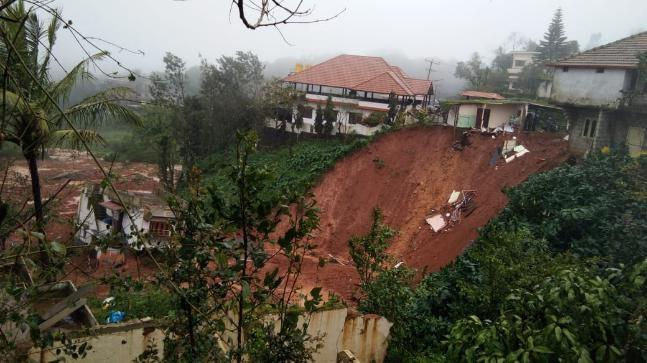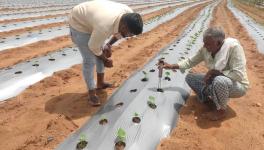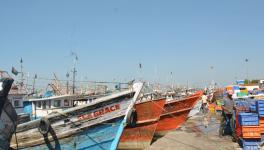Coorg In Karnataka Severely Flooded, Tamil Nadu Faces Threat As Dams Overflow

As Kerala grapples with relief operations after the most devastating rainfall-induced floods since 1924, bordering southern Karnataka’s Kodagu district — better known as Coorg — is also facing crisis caused by flooding and landslides after heavy incessant rains over the past few days. And in neighbouring Tamil Nadu, flood alert has been sounded for 13 districts.
Eight people have died — as per official figures — since 14 August in the floods in Kodagu district.
News agency IANS reported that 4,320 people had been rescued till 20 August.
READ MORE: Kerala Floods: Lies, Dam Lies & Statistics
But hundreds remain marooned in various parts of the hilly, coffee-growing district located in the Western Ghats. Low-lying areas have been completely inundated by the monsoon rains — which began in the first week of June — and all major roads leading to Kodagu are blocked. As on 18 August, 123 km of road have been damaged in Kodagu besides 58 culverts, 278 government buildings, and 3,899 electricity poles and transformers.
Airlifting by helicopters has not been possible so far due to diminished visibility in the rain and fog among the hilltops. But Chief Minister HD Kumaraswamy did conduct an aerial survey of many of the affected areas in the district on 18 and 19 August.
Rescue operations are in full-swing with at least 948 rescuers — as of 18 August — from multiple agencies involved. At least 75 boats and rafts were deployed from the Army Engineering Task Force.
The rescuers in Kodagu include 60 soldiers from the Dogra Regiment; 12 expert divers (surface rescuers) with rafts from the Indian Navy; 31 members of the National Disaster Response Force (NDRF); 525 members of the fire force, home guards and civil defence; 45 rescuers with from the civil defence (Quick Response Teams) with rafts and rescue equipment; and about 200 members of the NCC — while
READ MORE: Kerala Floods: How the State Govt. and the People Responded
In Dakshina Kannada district, which has also been inundated, at least 31 members of the NDRF and 300 members of the fire force, home guards and civil defence have been active. Other districts in Malnad region have also been flooded, although many of them are not densely populated.
The Hindu reported that, as on 18 August, the damage in Kodagu district included 123 km of road, 58 culverts, 278 government buildings, and 3,899 electricity poles and transformers. Five medical teams have also been sent to Kodagu. The newspaper said “the Bruhat Bengaluru Mahanagara Palike has deployed 300 pourakarmikas, seven health inspectors, and engineers.” The Hindu also reported that National Highway 275 had also been severely damaged.
Over the 24 hours between 19 and 20 August, reported the IANS, Kodagu district received an average of 6.1 cm of rainfall, while some other areas received a maximum rainfall of up to 10.3 cm, according to the Karnataka State Natural Disaster Monitoring Centre. The India Meteorological Department (IMD) has predicted that moderate to heavy rains are likely continue in the coastal districts of Udupi, Uttara Kannada and Dakshina Kannada till 22 August.
READ MORE: Kerala Floods: 255% Excess Rainfall in One Week
As for Tamil Nadu, the flood alerts were sounded in 13 districts — including the districts in the Cauvery delta region, besides Madurai and Theni — while around 14,000 people have been evacuated to relief camps in the state, reported The Times of India. Heavy amounts of water is being released from dams in the state, compounded by the inflows from Karnataka.
The shutters of the Vaigai dam in Theni district were opened and water released on 19 August as the water level reached 69 feet — the capacity of the dam is 71 feet. People living on the banks of the Vaigai river that runs through Theni and Madurai districts were issued a flood warning the same day and evacuated. Around 3,302 cusecs of water was released into the Vaigai river, as TOI reports.
Cauvery river is in full spate. As on the evening of 18 August, 2.05 lakh cusecs of water was discharged from Stanley Reservoir at Mettur dam across the Cauvery. Agricultural lands in the districts lying along the Cauvery have been destroyed. People were evacuated from the districts in the Cauvery delta — including Salem, Erode, Namakkal, Karur and Trichy.
READ MORE: Assassination of Dr Kalburgi – A Conspiracy to Eradicate the Culture of Dissent
Get the latest reports & analysis with people's perspective on Protests, movements & deep analytical videos, discussions of the current affairs in your Telegram app. Subscribe to NewsClick's Telegram channel & get Real-Time updates on stories, as they get published on our website.
























